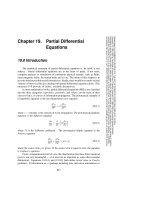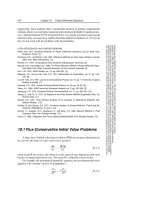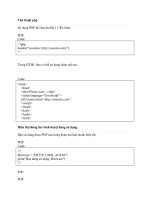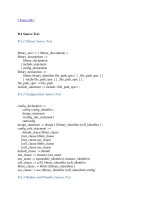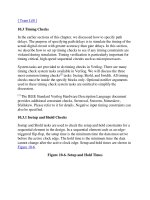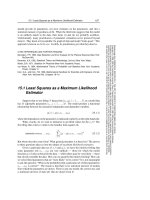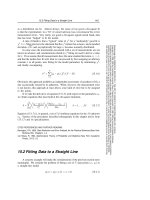Tài liệu Partial Differential Equations part 6 doc
Bạn đang xem bản rút gọn của tài liệu. Xem và tải ngay bản đầy đủ của tài liệu tại đây (152 KB, 9 trang )
19.5 Relaxation Methods for Boundary Value Problems
863
Sample page from NUMERICAL RECIPES IN C: THE ART OF SCIENTIFIC COMPUTING (ISBN 0-521-43108-5)
Copyright (C) 1988-1992 by Cambridge University Press.Programs Copyright (C) 1988-1992 by Numerical Recipes Software.
Permission is granted for internet users to make one paper copy for their own personal use. Further reproduction, or any copying of machine-
readable files (including this one) to any servercomputer, is strictly prohibited. To order Numerical Recipes books,diskettes, or CDROMs
visit website or call 1-800-872-7423 (North America only),or send email to (outside North America).
FACR Method
The best way to solve equations of the form (19.4.28), including the constant
coefficientproblem(19.0.3),isacombinationofFourieranalysisandcyclicreduction,
the FACR method
[3-6]
.Ifattherth stage of CR we Fourier analyze the equations of
the form (19.4.32) along y, that is, with respect to the suppressed vector index, we
will have a tridiagonal system in the x-direction for each y-Fourier mode:
u
k
j−2
r
+ λ
(r)
k
u
k
j
+u
k
j+2
r
=∆
2
g
(r)k
j
(19.4.35)
Here λ
(r)
k
is the eigenvalue of T
(r)
corresponding to the kth Fourier mode. For
the equation (19.0.3), equation (19.4.5) shows that λ
(r)
k
will involve terms like
cos(2πk/L) − 2 raised to a power. Solve the tridiagonal systems foru
k
j
at the levels
j =2
r
,2×2
r
,4×2
r
, ..., J − 2
r
. Fourier synthesize to get the y-values on these
x-lines. Then fill in the intermediate x-lines as in the original CR algorithm.
The trick is to choose the number of levels of CR so as to minimize the total
number of arithmetic operations. One can show that for a typical case of a 128×128
mesh, the optimal level is r =2; asymptotically, r → log
2
(log
2
J).
A rough estimate of running times for these algorithms for equation (19.0.3)
is as follows: The FFT method (in both x and y) and the CR method are roughly
comparable. FACR with r =0(that is, FFT in one dimension and solve the
tridiagonal equations by the usual algorithm in the other dimension) gives about a
factor of two gain in speed. The optimal FACR with r =2gives another factor
of two gain in speed.
CITED REFERENCES AND FURTHER READING:
Swartzrauber, P.N. 1977,
SIAM Review
, vol. 19, pp. 490–501. [1]
Buzbee, B.L, Golub, G.H., and Nielson, C.W. 1970,
SIAM Journal on Numerical Analysis
,vol.7,
pp. 627–656; see also
op. cit.
vol. 11, pp. 753–763. [2]
Hockney,R.W. 1965,
Journal of the Association for Computing Machinery
, vol. 12, pp. 95–113. [3]
Hockney, R.W. 1970, in
Methods of Computational Physics
, vol. 9 (New York: Academic Press),
pp. 135–211. [4]
Hockney, R.W., and Eastwood, J.W. 1981,
Computer Simulation Using Particles
(New York:
McGraw-Hill), Chapter 6. [5]
Temperton, C. 1980,
Journal of Computational Physics
, vol. 34, pp. 314–329. [6]
19.5 Relaxation Methods for Boundary Value
Problems
As we mentioned in §19.0, relaxation methods involve splitting the sparse
matrix that arises from finite differencing and then iterating until a solution is found.
There is another way of thinking about relaxation methods that is somewhat
more physical. Suppose we wish to solve the elliptic equation
Lu = ρ (19.5.1)
864
Chapter 19. Partial Differential Equations
Sample page from NUMERICAL RECIPES IN C: THE ART OF SCIENTIFIC COMPUTING (ISBN 0-521-43108-5)
Copyright (C) 1988-1992 by Cambridge University Press.Programs Copyright (C) 1988-1992 by Numerical Recipes Software.
Permission is granted for internet users to make one paper copy for their own personal use. Further reproduction, or any copying of machine-
readable files (including this one) to any servercomputer, is strictly prohibited. To order Numerical Recipes books,diskettes, or CDROMs
visit website or call 1-800-872-7423 (North America only),or send email to (outside North America).
where L represents some elliptic operator and ρ is the source term. Rewrite the
equation as a diffusion equation,
∂u
∂t
= Lu − ρ (19.5.2)
An initial distribution u relaxes to an equilibrium solution as t →∞.This
equilibrium has all time derivatives vanishing. Therefore it is the solution of the
originalellipticproblem(19.5.1). We see that all the machinery of §19.2, on diffusive
initial value equations, can be brought to bear on the solution of boundary value
problems by relaxation methods.
Let us apply this idea to our model problem (19.0.3). The diffusion equation is
∂u
∂t
=
∂
2
u
∂x
2
+
∂
2
u
∂y
2
− ρ (19.5.3)
If we use FTCS differencing (cf. equation 19.2.4), we get
u
n+1
j,l
= u
n
j,l
+
∆t
∆
2
u
n
j+1,l
+ u
n
j−1,l
+ u
n
j,l+1
+ u
n
j,l−1
− 4u
n
j,l
− ρ
j,l
∆t (19.5.4)
Recall from (19.2.6) that FTCS differencing is stable in one spatial dimension only if
∆t/∆
2
≤
1
2
. In two dimensions this becomes ∆t/∆
2
≤
1
4
. Suppose we try to take
the largest possible timestep, and set ∆t =∆
2
/4. Then equation (19.5.4) becomes
u
n+1
j,l
=
1
4
u
n
j+1,l
+ u
n
j−1,l
+ u
n
j,l+1
+ u
n
j,l−1
−
∆
2
4
ρ
j,l
(19.5.5)
Thus the algorithm consists of using the average of u at its four nearest-neighbor
points on the grid (plus the contribution from the source). This procedure is then
iterated until convergence.
This method is in fact a classical method with origins dating back to the
last century, called Jacobi’s method (not to be confused with the Jacobi method
for eigenvalues). The method is not practical because it converges too slowly.
However, it is the basis for understanding the modern methods, which are always
compared with it.
Another classical method is the Gauss-Seidel method, which turns out to be
important in multigridmethods (§19.6). Here we make use of updated values of u on
the right-hand side of (19.5.5) as soon as they become available. In other words, the
averaging is done “in place” instead of being “copied” from an earlier timestep to a
later one. If we are proceeding along the rows, incrementing j for fixed l,wehave
u
n+1
j,l
=
1
4
u
n
j+1,l
+ u
n+1
j −1,l
+ u
n
j,l+1
+ u
n+1
j,l−1
−
∆
2
4
ρ
j,l
(19.5.6)
This method is also slowly converging and only of theoretical interest when used by
itself, but some analysis of it will be instructive.
Let us look at the Jacobi and Gauss-Seidel methods in terms of the matrix
splitting concept. We change notation and call u “x,” to conform to standard matrix
notation. To solve
A · x = b (19.5.7)
19.5 Relaxation Methods for Boundary Value Problems
865
Sample page from NUMERICAL RECIPES IN C: THE ART OF SCIENTIFIC COMPUTING (ISBN 0-521-43108-5)
Copyright (C) 1988-1992 by Cambridge University Press.Programs Copyright (C) 1988-1992 by Numerical Recipes Software.
Permission is granted for internet users to make one paper copy for their own personal use. Further reproduction, or any copying of machine-
readable files (including this one) to any servercomputer, is strictly prohibited. To order Numerical Recipes books,diskettes, or CDROMs
visit website or call 1-800-872-7423 (North America only),or send email to (outside North America).
we can consider splitting A as
A = L + D + U (19.5.8)
where D is the diagonal part of A, L is the lower triangle of A with zeros on the
diagonal, and U is the upper triangle of A with zeros on the diagonal.
In the Jacobi method we write for the rth step of iteration
D · x
(r)
= −(L + U) · x
(r−1)
+ b (19.5.9)
For our model problem (19.5.5), D is simply the identity matrix. The Jacobi method
converges for matrices A that are “diagonally dominant” in a sense that can be
made mathematically precise. For matrices arising from finite differencing, this
condition is usually met.
What is the rate of convergence of the Jacobi method? A detailed analysis is
beyond our scope, but here is some of the flavor: The matrix −D
−1
· (L + U) is
the iteration matrix which, apart from an additive term, maps one set of x’s into the
next. The iteration matrix has eigenvalues, each one of which reflects the factor by
which the amplitude of a particular eigenmode of undesired residual is suppressed
during one iteration. Evidently those factors had better all have modulus < 1 for
the relaxation to work at all! The rate of convergence of the method is set by the
rate for the slowest-decaying eigenmode, i.e., the factor with largest modulus. The
modulus of this largest factor, therefore lying between 0 and 1, is called the spectral
radius of the relaxation operator, denoted ρ
s
.
The number of iterations r required to reduce the overall error by a factor
10
−p
is thus estimated by
r ≈
p ln 10
(− ln ρ
s
)
(19.5.10)
In general, the spectral radius ρ
s
goes asymptotically to the value 1 as the grid
size J is increased, so that more iterations are required. For any given equation,
grid geometry, and boundary condition, the spectral radius can, in principle, be
computed analytically. For example, for equation (19.5.5) on a J × J grid with
Dirichlet boundary conditions on all four sides, the asymptotic formula for large
J turns out to be
ρ
s
1 −
π
2
2J
2
(19.5.11)
The number of iterations r required to reduce the error by a factor of 10
−p
is thus
r
2pJ
2
ln 10
π
2
1
2
pJ
2
(19.5.12)
In other words, the number of iterationsis proportionalto the number of mesh points,
J
2
.Since100 × 100 and larger problems are common, it is clear that the Jacobi
method is only of theoretical interest.
866
Chapter 19. Partial Differential Equations
Sample page from NUMERICAL RECIPES IN C: THE ART OF SCIENTIFIC COMPUTING (ISBN 0-521-43108-5)
Copyright (C) 1988-1992 by Cambridge University Press.Programs Copyright (C) 1988-1992 by Numerical Recipes Software.
Permission is granted for internet users to make one paper copy for their own personal use. Further reproduction, or any copying of machine-
readable files (including this one) to any servercomputer, is strictly prohibited. To order Numerical Recipes books,diskettes, or CDROMs
visit website or call 1-800-872-7423 (North America only),or send email to (outside North America).
The Gauss-Seidel method, equation (19.5.6), corresponds to the matrix de-
composition
(L + D) · x
(r)
= −U · x
(r−1)
+ b (19.5.13)
The fact that L is on the left-hand side of the equation follows from the updating
in place, as you can easily check if you write out (19.5.13) in components. One
can show
[1-3]
that the spectral radius is just the square of the spectral radius of the
Jacobi method. For our model problem, therefore,
ρ
s
1 −
π
2
J
2
(19.5.14)
r
pJ
2
ln 10
π
2
1
4
pJ
2
(19.5.15)
The factor of two improvement in the number of iterations over the Jacobi method
still leaves the method impractical.
Successive Overrelaxation (SOR)
We get a better algorithm— one that was the standard algorithm until the 1970s
—ifwemakeanovercorrection to the value of x
(r)
at the rth stage of Gauss-Seidel
iteration, thus anticipating future corrections. Solve (19.5.13) for x
(r)
,addand
subtract x
(r−1)
on the right-hand side, and hence write the Gauss-Seidel method as
x
(r)
= x
(r−1)
− (L + D)
−1
· [(L + D + U) · x
(r−1)
− b](19.5.16)
The term in square brackets is just the residual vector ξ
(r−1)
,so
x
(r)
=x
(r−1)
− (L + D)
−1
· ξ
(r−1)
(19.5.17)
Now overcorrect, defining
x
(r)
= x
(r−1)
− ω(L + D)
−1
· ξ
(r−1)
(19.5.18)
Here ω is called the overrelaxation parameter, and the method is called successive
overrelaxation (SOR).
The following theorems can be proved
[1-3]
:
• The method is convergent only for 0 <ω<2.If0<ω<1, we speak
of underrelaxation.
• Under certain mathematical restrictions generally satisfied by matrices
arising from finite differencing, only overrelaxation (1 <ω<2) can give
faster convergence than the Gauss-Seidel method.
• If ρ
Jacobi
is the spectral radius of the Jacobi iteration (so that the square
of it is the spectral radius of the Gauss-Seidel iteration), then the optimal
choice for ω is given by
ω =
2
1+
1−ρ
2
Jacobi
(19.5.19)
19.5 Relaxation Methods for Boundary Value Problems
867
Sample page from NUMERICAL RECIPES IN C: THE ART OF SCIENTIFIC COMPUTING (ISBN 0-521-43108-5)
Copyright (C) 1988-1992 by Cambridge University Press.Programs Copyright (C) 1988-1992 by Numerical Recipes Software.
Permission is granted for internet users to make one paper copy for their own personal use. Further reproduction, or any copying of machine-
readable files (including this one) to any servercomputer, is strictly prohibited. To order Numerical Recipes books,diskettes, or CDROMs
visit website or call 1-800-872-7423 (North America only),or send email to (outside North America).
• For this optimal choice, the spectral radius for SOR is
ρ
SOR
=
ρ
Jacobi
1+
1−ρ
2
Jacobi
2
(19.5.20)
As an application of the above results, consider our model problem for which
ρ
Jacobi
is given by equation (19.5.11). Then equations (19.5.19) and (19.5.20) give
ω
2
1+π/J
(19.5.21)
ρ
SOR
1 −
2π
J
for large J (19.5.22)
Equation (19.5.10) gives for the number of iterations to reduce the initial error by
a factor of 10
−p
,
r
pJ ln 10
2π
1
3
pJ (19.5.23)
Comparing with equation (19.5.12) or (19.5.15), we see that optimal SOR requires
of order J iterations, as opposed to of order J
2
.SinceJis typically 100 or larger,
this makes a tremendous difference! Equation (19.5.23) leads to the mnemonic
that 3-figure accuracy (p =3) requires a number of iterations equal to the number
of mesh points along a side of the grid. For 6-figure accuracy, we require about
twice as many iterations.
How do we choose ω for a problem for which the answer is not known
analytically? That is just the weak point of SOR! The advantages of SOR obtain
only in a fairly narrow window around the correct value of ω. It is better to take ω
slightly too large, rather than slightly too small, but best to get it right.
One way to choose ω is to map your problem approximately onto a known
problem, replacing the coefficients inthe equation by average values. Note, however,
that the known problem must have the same grid size and boundary conditionsas the
actual problem. We give for reference purposes the value of ρ
Jacobi
for our model
problem on a rectangular J × L grid, allowing for the possibility that ∆x =∆y:
ρ
Jacobi
=
cos
π
J
+
∆x
∆y
2
cos
π
L
1+
∆x
∆y
2
(19.5.24)
Equation (19.5.24) holds for homogeneous Dirichlet or Neumann boundary condi-
tions. For periodic boundary conditions, make the replacement π → 2π.
A second way, which is especially useful if you plan to solve many similar
elliptic equations each time with slightly different coefficients, is to determine the
optimum value ω empirically on the first equation and then use that value for the
remaining equations. Various automated schemes for doing this and for “seeking
out” the best values of ω are described in the literature.
While the matrix notation introduced earlier is useful for theoretical analyses,
for practical implementation of the SOR algorithm we need explicit formulas.
